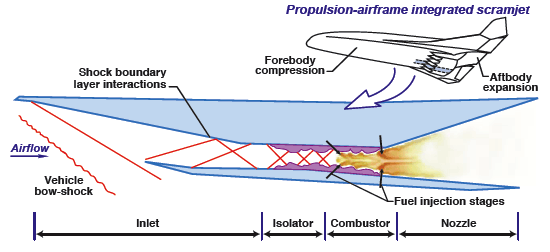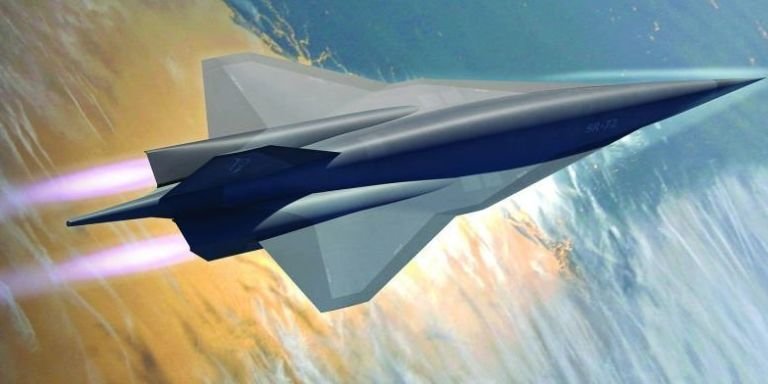Throughout aviation history, few aircraft profiles are as familiar or evoke such a visceral reaction as the cold war era SR-71 Blackbird. Its sleek design, black titanium outer shell, and massive twin jet engines almost give the illusion it is moving at its record-breaking Mach 3.5 even when standing still.
Now, the original designer of the Blackbird, Lockheed-Martin Skunk Works, is developing a replacement for the long-retired SR-71, a craft dubbed the “SR-72.”
Given the project’s top-secret nature, the company is being particularly cagey, and details are sketchy at best. Still, by all accounts, this latest combination of stealth and speed will likely boast several upgrades over its predecessor, including a faster top speed, possibly even doubling what the original could achieve.
Background: Is There an SR-72?
Since the first official retirement of the Blackbird by the USAF in 1989, followed by spot duty come-backs until its final, final retirement in 1999, rumors of a replacement vehicle have swirled. Initially, the ultra-stealthy, hypersonic concept vehicle “Aurora” led the pack. However, the lack of evidence for its existence, and with no official announcement being made about the craft, it has since been relegated to nothing more than fantasy.
Satellites, drones, and other modern systems have filled the intelligence-gathering hole left by the retired Blackbird ever since, leaving many to wonder if a replacement for the once cutting-edge vehicle would ever come to fruition.
In 2013, Lockheed Martin privately proposed the SR-72 to the U.S. Air Force as a successor to the SR-71, followed by an official confirmation to Aviation Week in 2017.
“Although I can’t go into specifics,” Orlando Carvalho, an Executive Vice President of Aeronautics at Lockheed Martin, said at the time, “let us just say the Skunk Works team in Palmdale, California, is doubling down on our commitment to speed. Simply put, I believe the United States is on the verge of a hypersonics revolution.”
A few months later, Jack O’Banion, Vice president at Lockheed Martin Skunkworks, gave some more hints at the American Institute of Aeronautics and Astronautics’ annual SciTech Forum, specifically pointing to the digital revolution that had allowed engineers to design a three-dimensional scramjet engine. This cutting-edge powerhouse will purportedly drive the craft at speeds approaching Mach 6.
“Without (this) digital transformation,” O’Banion said, before showing a slide of the SR-72 to the crowd, “the aircraft you see there could not have been made. But now we can digitally print that engine with an incredibly sophisticated cooling system integral into the material of the engine itself and have that engine survive for multiple firings for routine operation.”
Analysis: Packing a Serious Punch
By 2021, little else on the project has been released, and in an email to The Debrief, Skunkworks team member Melissa Daulton said, “This is a highly sensitive mission area, and I don’t have anything specific that I can share.”
Fortunately, at least some of the proposed craft’s technical components have come to light since 2018, including a trio of significant upgrades over its long-retired predecessor craft.
First are the hypersonic scramjet engines, which allegedly can achieve speeds of Mach 6, or over 4,500 miles per hour (although the company notes that the security classifications involved only let them currently confirm a speed of Mach 5). Lockheed has been testing these types of ultra-high-speed, air-breathing supersonic combustible ramjets for years, including a string of successful tests at the end of last year. Some speculation exists that the craft’s engine may end up being a hybrid scramjet and rocket engine. Known as a combined cycle propulsion system, the SR-72 could theoretically reach even higher top speeds, but those plans have not yet been confirmed.
“Hypersonics is like stealth,” Carvalho told Aviation Week in their original piece, “It is a disruptive technology and will enable various platforms to operate at two to three times the speed of the Blackbird.”


Another upgrade over its predecessor is the ability to fly the craft remotely like a conventional drone or even task the vehicle to be flown by an AI pilot like the USAF successfully tested in December 2020. Some final versions may also end up being piloted by humans, but the scale model glimpsed by reporters in 2017 at the SkunkWorks Palmdale, California facility was reportedly an unmanned, remote-controlled drone.
Finally, unlike its unarmed predecessor, the SR-72 may be armed. This significant change moves the vehicle from a high-speed reconnaissance craft to a fully realized first-strike aircraft capable of arriving at Mach 5+, releasing its weapons payload, and then retreating at the same neck-breaking speed.
It is a significant upgrade over current capabilities, or as Lockheed Martin’s website states, “The next five years will be a critical time in development of hypersonic strike systems. Traveling at speeds of over Mach 5 (compared to the speed of sound at Mach 1), these systems are built with advanced material that can sustain extremely hot and cold temperatures within space.”
The SR-72 carries a potent set of upgrades, and it is a vehicle that Skunkworks hopes to have in full demonstration mode by 2025, followed by real-world deployment in the 2030s.
Outlook: Does the SR-72 Have a Future?
“We’ve been saying hypersonics is two years away for the last 20 years,” said Rob Weiss, Lockheed Martin’s Executive Vice President and General Manager for Skunk Works, during the American Institute of Aeronautics and Astronautics forum in Denver, Colorado, in June 2018. “But all I can say is the technology is mature and we, along with DARPA and the services, are working hard to get that capability into the hands of our warfighters as soon as possible.”
Considering that the original SR-71 Blackbird was so fast, it allegedly outran every missile Russian MIG fighters threw at it; this latest SkunkWorks invention looks to be another game-changer.
From hypersonic speed, remote (or even AI) control, and an ability to deliver a weapons payload at speeds previously achievable only by rocket-powered craft, the SR-72 may one day provide an unparalleled combination of speed, stealth, and strike capability.

